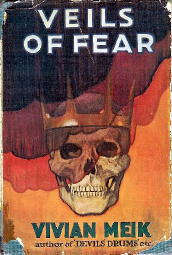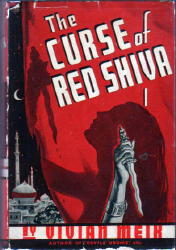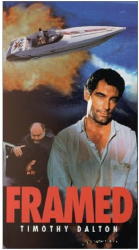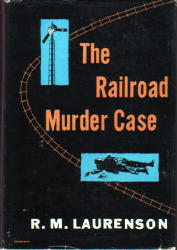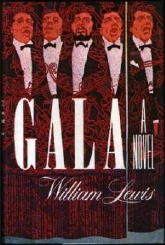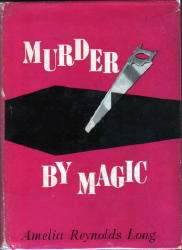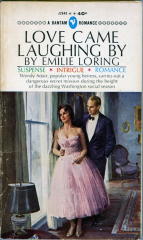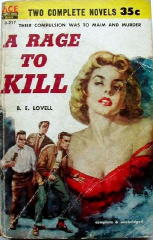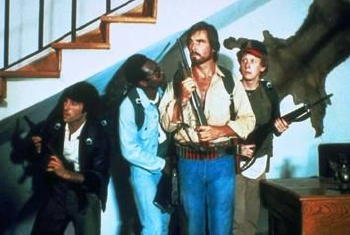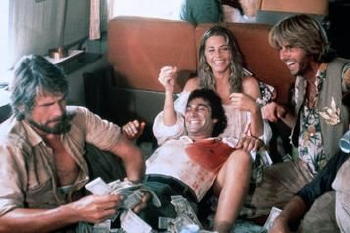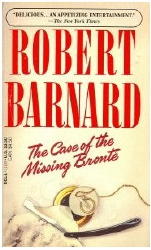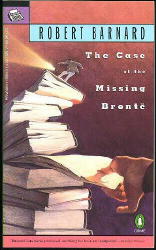June 2007
Monthly Archive
Thu 21 Jun 2007
Vivian (Bernard) Meek came to my attention when one of his books, The Curse of Red Shiva, appeared in the Hillman-Curl line of mysteries, covers of which I’ve been gradually uploading to the Murder at 3 Cents a Day website.
Mr. Meek was born in 1894 and, as recently discovered by Victor Berch, died in California in 1955. Some short biographical notes online describe him as being an author, engineer and a war correspondent. In the course of these occupations he was also a dedicated world traveler, spending much time in India and the surrounding territory. In addition to his suspense and horror fiction, for which he is probably best known today, he wrote The People of the Leaves (Philip Allan, UK, 1931; Henry Holt, 1931), an anthropological study of an obscure tribe called the Juang located in Orissa, a sizable state along the east coast of the Indian subcontinent.
UPDATE: While waiting for me to complete my commentary on the books themselves, Victor came up with the following additional information on the author:
Here is some info I picked up from various documents I found, the most informative being the information Meik supplied on his flight to the US for permanent residency here. According to the California Death Index, Meik was born June 21, 1894 and died December 22, 1955. Another database gives his birth date as July 21, 1894, however.
Supposedly born in Calcutta, India, on the flight information, Meik claims he was born at sea on a British vessel. From another document, his father was a Lorenzo Meik and his mother was Alice Gertrude Thomas Meik. Another document lists his wife’s name as Bernadette Marie Desparadze. Going back to the flight document, the following further information is supplied:
His flight left Frankfort, Germany June 21, 1947 and arrived in NY on June 22, 1947. His passport was issued June 14, 1947, a week before his 53rd birthday.
Height: 6 feet
Complexion: Swarthy
Last permanent residence: 41 Denman Drive, London
Occupation: Journalist
Intention: Permanent residency in US. He was going to stay with an uncle, Francis T. Meik of Salt Lake City, Utah
Age: 52
There was no indication that his wife ever joined him. One outstanding feature that he had when he arrived in the US was that he was missing his left eye.
I’m back. I have not located a usable cover scan for this first book, a collection of horror fiction, but the contents are listed in Crime Fiction IV, by Allen J. Hubin, who indicates that some of the stories are also crime-related. Note the slight correction in the title: the apostrophe is correctly after the “s”.
Devils’ Drums (Philip Allan, UK, 1933; Midnight House, US, in preparation, Douglas A. Anderson, editor)
* • An Acre in Hell • ss
* • Devils’ Drums • ss
* • The Doll of Death • nv
* • Domira’s Drum • ss
* • The Honeymoon in Hate • ss
* • L’Amitie Reste • ss
* • The Man Who Sold His Shadow • ss
* • Ra • ss
* • White Man’s Law • ss
* • White Zombie • ss
The volume edited by Doug Anderson will contain three additional stories:
* • Chimoro
* • I Leave It to You
* • The Two Old Women
A second book, also published by Philip Allan in that publisher’s “Creeps series,” is a novel rather than a short story collection; it is nonetheless considered to be a sequel to the preceding one:
Veils of Fear (Philip Allan, 1934)
The book is not presently included in CFIV, but Bill Pronzini says that in addition to featuring a reporter named Neil Martyn, “There are some homicides and suspense elements but they seem to be pretty much connected to the occult horror theme. Settings range from Port Said to the Far East.”
On this basis, Al Hubin has indicated that the book will appear in an upcoming Addenda installment to the Revised Crime Fiction IV, but with a dash to indicate that it is only marginally criminous.
Doug Anderson has more to say about the two books: “While Neil Martyn is the main point of view character, the [returning] series characters in Veils of Fear are Geoffrey Aylett and Padre Jan Vaneken. Both appear, along with others (Peter Verrey; one Vereker, no first name given; and Doctor Strang) in Devils’ Drums (and two – Vereker and Strang – are mentioned in the short story ‘The Two Old Women’.”
The final work of fiction from the pen of Vivian Meik is also the only one which to this date has been published in the US, also a novel:
The Curse of the Red Shiva. (Philip Allan, 1936; Hillman-Curl, 1938.)
Jacket blurb: Taken from the Hillman-Curl edition.
“You will gasp for mercy for your children as I have cried for mine, and only the striking blade will be the answer. Behold! By Red Shiva I curse you!” A knife gleamed in her hand as it flashed downward and buried itself in her heart.
More than a century and a half since those words were uttered by a beautiful Indian slave to Peter Trenton, adventurer …
But now, after five generations, Sir Peter Trenton was found under Westminster Bridge, brutally murdered, a gold mohur tied around his neck.
Sir Derek Balliol had guessed the significance of the series of murders – but he was killed before he could speak! Only Verrey was left … and against him were pitted the cunning powers behind the newly-awakened race consciousness of the East.
Review excepts: [Isaac Anderson, New York Times] “This is just the book for those who like tall tales of Oriental intrigue and of menaces to the supremacy of the white race.”
[Saturday Review of Literature]. “Blood and thunder yarn of slinking Eurasians, renegade whites, stranglings, etc., with reasonably good detective trimmings.”
[Bill Pronzini, earlier on the Mystery*File blog]. “A Sax Rohmerish adventure mystery with a screwball plot.”
Short fiction: [This list, which includes reprint appearances, is probably not complete. Doug Anderson promises that his edition of Devils’ Drums will include a more extensive bibliography as well as additional details of the author’s life, including where and when he lost one eye.]
* • Chimoro. To be included in the expanded Devils’ Drums. From Doug Anderson: “This is an extract from a chapter of one of his autobiographical volumes, Zambezi Interlude (1932). It reads exactly like one of his stories.”
* • The Doll of Death. From Devils’ Drums. Reprinted in The Sixth Pan Book of Horror Stories, Herbert van Thal, editor; Pan, pb, 1965. Televised on Night Gallery, NBC, Sunday, May 20, 1973.
* • A Honeymoon in Hate. From Devils’ Drums. Reprinted in A Wave of Fear, Hugh Lamb, editor; W. H. Allen, 1973; Taplinger, US, hc, 1974.
— Mikalongwa, Angoniland. English refugees Blair Taylor and Martin Kemp are bitter rivals for the love of the beautiful Estelle. When she decides to marry Taylor, Kemp turns to black magic and drives him to madness and suicide. Estelle avenges her beloved by marrying his murderer, having first infected herself with the blood of a leper. On their wedding night she performs a macabre striptease …
* • I Leave It to You. From ?? Included in Another Corner Seat Omnibus, Anonymous, editor; Grafton Publications, March 1945. To be included in the expanded Devils’ Drums.
* • The Two Old Women. From Monsters, A Collection of Uneasy Tales, Charles Birkin, editor. Philip Allan, 1934. Reprinted in The Fourth Pan Book of Horror Stories, Herbert van Thal, editor; Pan, pb, 1963. To be included in the expanded Devils’ Drums.
Thu 21 Jun 2007
AGATHA CHRISTIE – N or M?
Dell 187, reprint paperback: mapback edition; no date stated, but generally accepted as 1947. Hardcover editions: Collins Crime Club (UK), 1941; Dodd, Mead (US), 1941.
I will not be so foolhardy as to list all of the editions that this book has been published in, nor will I supply more than the front and back cover of this particular mapback edition, especially since the jackets of the respective hardcover editions are so rather plain and unexciting.
But speaking of mapbacks, what I just realized now, strangely enough, is that not once while reading N or M? did I refer to the back cover. Not until getting an image ready for uploading did I even think of it. And so, looking it just now, I find it utterly remarkable that while I all of the geographical details of the small seaside resort town of Leahampton essentially wrong in my mind, the overall picture in my head was exactly right. (And of course who is there to say that the artist who drew the map had the details right?)
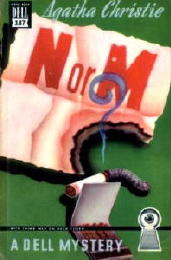
This is a Tuppence and Tommy (Beresford) book, and if you were to check the date that the book was published (1941), you might immediately gather that this wartime book had something to do with the war, and indeed it does. (It is my impression that relatively few murder mysteries published during the war ever mentioned the war, but this one does, and directly so. Other handedly, my impression could be totally false. It is a subject worthy of further investigation.)
I have not read the earlier books in the Tuppence and Tommy series in quite some time, so I do not recall in which one of them the twosome were secret agents in World War I, but when this book begins, they are beginning to feel their age, not to mention the pain of their rejection, as sitting on the sidelines is not their idea of how to spend the time they find free on their hands, nor in any way how to make the best use of their abilities.
A small pause here while I investigate and come back with a short list of the books in which the pair of intrepid adventurers appeared:
The Secret Adversary, 1922. [This must be the World War I adventure .]
Partners in Crime, 1929. [A story collection disguised as a novel.]
N or M?, 1941.
By the Pricking of My Thumbs, 1968.
Postern of Fate, 1973.
That’s quite a range of dates, and the gap between the 3rd and 4th is a huge one, 27 years, but I don’t imagine that it is anywhere near a record — the longest break between appearance of series characters. (A question like this is something else I wish I had more time to look into.)
But back to the story. Luckily enough Tommy is offered a job by the British equivalent of Homeland Security, so hush-hush, he is advised, that he should not even tell Tuppence. Who, of course, has other ideas, and thus indeed there is a story.
It seems that a pair of spies for the Germans, N (a man) and M (a woman) are located in the aforementioned seaside resort town of Leahampton, and in particular they may even be living there in a private hotel called Sans Souci. An amateur is precisely what is required, Tommy is told, as a professional would be spotted right away.
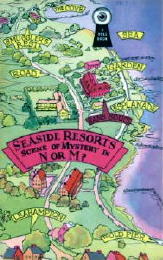
During wartime towns like Leahampton would be populated by (as related on page 14): “old ladies, old colonels, unimpeachable spinsters, dubious customers, fishy customers, a foreigner or two. In fact, a mixed bag.” And the two spies, Tommy again is advised, are among them.
Now if there are people Agatha Christie could write about more capably than “old ladies, old colonels, unimpeachable spinsters, dubious customers, fishy customers, a foreigner or two,” I don’t know who they would be, nor do I know of any other mystery writer could outdo her in this regard, either.
What with the number of people staying on at Sans Souci to describe and make distinguishable, it might have been a Herculean task to succeed in doing so, but what Agatha Christie had was a knack of instant characterization for the inhabitants of her stories, and so it is here. And there is more. Christie is often put down for mysteries that focus more on the plots than they do on the writing of them, but such critics are generally wrong, as this book amply demonstrates. It is so smoothly written that 50 pages flash by in what seems to be an instant — gently humorous at times, sometimes (later on) deadly serious, and with a sense that something suspicious is always going on.
There are a good many suspects at hand, in other words, in an oddly arranged version of the closed manor house type of mystery, but with little of substance to back up this statement, I do not believe that spies and espionage were Ms. Christie’s strongest points. Or in other words, where the book fails, if indeed it does, is in the plotting, which seems forced and unconvincing, concluding with some derring-do and remarkable rescuing that seems entirely fortuitous.
And that the bring-down-the-curtain revelation at the end was one that I was suspicious about myself several pages earlier — “What’s going on here?” I wondered to myself (you’ll have to take my word for it) — which only goes to reinforce the statement I made in the preceding paragraph. Entirely enjoyable then, is my conclusion, but weakest precisely (and curiously) where you’d expect an Agatha Christie novel not to be.
Tue 19 Jun 2007
Al Hubin is now working on Part 16 of his Addenda to the Revised Crime Fiction IV; if you follow the link, the first 15 are now online. I’m still working on Part 3, adding images, commentary and various links. Here are most of the L’s, which I’ve finished up recently:
LANE, JEREMY Author of six mystery novels listed in the (Revised) Crime Fiction IV. Two were published in the late twenties, the remaining four from Phoenix Press between 1944 and 1949. The detective in all four of the Phoenix books was Dr. Whitney Wheat, a psychiatrist.
Kill Him Tonight. Add setting: New York City.
LA PLANTE, LYNDA (née TITCHMARSH) Add maiden name.
Framed. Novelization of TV movie [2 x 2 hour miniseries]: Anglia/A&E, 1992 (scw: Lynda La Plante; dir: Geoffrey Sax). Also: TV movie: TNT, 2003 (scw & dir: Daniel Petrie, Jr.) [Correct title and delete previous SC identification.]
Prime Suspect. TV movie [2 x 2 hr miniseries]: Granada, 1991 (scw: Lynda La Plante; dir: Christopher Menaul). SC: DCI Jane Tennison (Helen Mirren)
Prime Suspect 2. [Add title.] Mandarin pb, 1992; Dell, 1993. TV movie [4-part mini-series] Granada, 1992 (scw: Alan Cubitt; dir: John Strickland). SC: DCI Jane Tennison (Helen Mirren)
Prime Suspect 3. TV movie [2 x 2 hour miniseries]: Granada, 1993 (scw: Lynda La Plante; dir: David Drury), SC: DCI Jane Tennison (Helen Mirren)
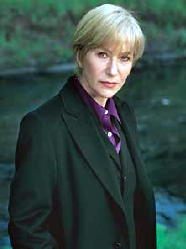
Trial and Retribution. [ghost written by Robin Blake, q.v.] Macmillan (London), 1997. TV movie [2 x 2 hour mini-series ]: La Plante, 1997 (scw: Lynda La Plante; dir: Aisling Walsh). SC: Det. Supt. Michael Walker (David Hayman) & Det. Insp. Pat North (Kate Buffery)
Trial and Retribution II. [ghost written by Robin Blake, q.v.] Macmillan (London), 1998. TV movie [2 x 2 hour mini-series]: La Plante, 1998 (scw: Lynda La Plante; dir: Aisling Walsh). SC: Det. Supt. Michael Walker (David Hayman) & Det. Insp. Pat North (Kate Buffery)
Trial and Retribution III. [ghost written by Robin Blake, q.v.] Macmillan (London), 1999. TV movie [2 x 2 hour mini-series]: La Plante, 1999 (scw: Lynda La Plante; dir: Jo Johnson). SC: Det. Supt. Michael Walker (David Hayman) & Det. Insp. Pat North (Kate Buffery)
Trial and Retribution IV. Novelization of TV series by Robin Blake, q.v., based on scripts by Lynda La Plante.
The Widows. Novelization of TV movie [6-part mini-series]: Euston/Thames, 1983 (scw: Lynda La Plante; dir: Ian Toynton). SC: Dolly Rawlins (Ann Mitchell). Also: TV movie [mini-series]: ABC, 2002 (scw: Lynda La Plante; dir: Geoffrey Sax). SC: Dolly Rawlins (Mercedes Ruehl)
The Widows II. Novelization of TV movie [6-part mini-series]: Euston/Thames, 1985 (scw: Lynda La Plante; dir: Paul Annett). SC: Dolly Rawlins (Ann Mitchell)
LARSON, GLEN A. Television writer and producer. Nominal co-author (with Roger Hill, q.v.) of five novelizations of the TV series Knight Rider. It is understood that Hill did all of the writing. The remaining four books were also based on individual one- or two-part episodes of the show; follow the preceding link for more information.
Knight Rider. TV movie: Universal, 1982 (scw: Tom Greene, Glen A. Larson; dir: Daniel Haller). SC: Michael Knight (David Hasselhoff)
LAURENSON, R. M. Author of three books listed in the (Revised) Crime Fiction IV, two of them from Phoenix Press (1948-1949) with series character Marc Jordan, a railroad attorney. The book below is the first of his two cases.
The Railroad Murder Case. Add setting: Illinois.
LEWIS, BEATRICE MARY Pseudonym: Lewis Iram, q.v.
LEWIS, MICHAEL (ARTHUR). British author of five detective novels between 1925 and 1931 listed in the (Revised) Crime Fiction IV. SC: Detective Insp. Anthony Field = AF. [Sergeant Hobbs was previously listed as being a series character in the two books marked *.]
* The Brand of the Beast. AF
* The Island of Disaster. AF
The Three Amateurs. AF
LEWIS, WILLIAM (L.) 1931- . Noted operatic tenor. Add year of birth and middle initial. In his one work of crime fiction included in the (Revised) Crime Fiction IV, listed below, five singers are the targets of a serial killer.
Gala (Dutton, 1987, hc) [New York City, NY; Theatre]
LOGAN, MALCOLM. Co-author with Carolynne Logan of one mystery novel included in the (Revised) Crime Fiction IV; see below. Delete previously stated birth & death dates, both tentative. Leading character: “Former boy prodigy” Justus Drumm.
One of These Seven. Mystery House, hc, 1946. [New York City, NY]
LONDON, JOAN. 1901-1971. Daughter of well-known author Jack London. Joint pseudonym with her husband Barney Mayes, 1905(?)-1978(?), q.v.: B. J. Maylon, q.v.
LONG, AMELIA REYNOLDS. Add settings for the mystery novels below; the series characters stated are already included in the (Revised) Crime Fiction IV:
The Corpse at the Quill Club. SC: Mystery writer Katherine “Peter” Piper; criminal psychologist Edward Trelawney. [Philadelphia]
Death Has a Will. SC: Attorney Steve Carter. [Pennsylvania]
The Lady Saw Red. SC: Katherine “Peter” Piper. [Pennsylvania]
Murder by Magic. SC: Steve Carter. [Pennsylvania]
Murder Times Three. SC: Edward Trelawney. [Philadelphia]
Murder to Type. SC: Steve Carter. [Pennsylvania]
LORAC, E. C. R. Pseudonym of Edith Caroline Rivett, (1894-1958); other pseudonym Carol Carnac. Prolific author of over 70 mystery novels under both pen names; her primary detective for the Lorac books is Chief Inspector Robert Macdonald. He is in the book below.
Murder by Matchlight. Add setting: London.
LORING, EMILIE. 1866-1951. [See the second comment below.] Most of this British author’s books were romantic fiction, published between 1922 and 1950; unfinished material discovered after her death was developed into an additional 20 romances (1952-1972). Add the title below.
Love Came Laughing By. Little, 1949 [Washington D.C.]
LOTTMAN, EILEEN
Welcome Home, Jaime. TV movie [two-part series pilot for The Bionic Woman]: Universal, 1976, as Welcome Home, Jaime (scw: Kenneth Johnson; dir: Alan Crosland). SC: Jamie Summers (Lindsay Wagner)
LOVELL, B(OYD) E. 1920-1962. Add full first name and year of death. Author of two mystery novels included in the (Revised) Crime Fiction IV, both with private eye Edge Hannagan.
(Mabel) DANA LYON. See joint pseudonym with (Josephine Hughston, q.v.) Dana Hughston, q.v. Note that Lyon and Hughston also shared a dual byline on the book cited below, previously included in the (Revised) Crime Fiction IV:
The Bathtub Murder (U.S.: Williams, 1933, hc)
Sun 17 Jun 2007
It isn’t very difficult to create a “compleat” entry for a mystery writer when the writer has only one mystery novel to his credit, as is the case for Lee Gifford, which is quite possible a pseudonym. But as you can imagine — think about it for a bit — it’s not easy doing a Google search for anyone with a name like this. Screening out all of the unwanted entries produced nothing of interest. I also could not locate any other book, fiction or non-fiction, that I could ascribe to the name.
The reason I suspect that Gifford is a pen name is that the single book in question is not copyright in the name of the author, but by Fawcett Publications, long time publisher of the well-known (and widely collectible) line of Gold Medal paperbacks. Any further information about the writer would be welcome.
His entry in Crime Fiction IV, by Allen J. Hubin, slightly expanded:
GIFFORD, LEE
* Pieces of the Game. Gold Medal s1008, pbo, June 1960. Setting: Far East; WWII.
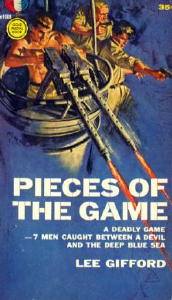
From the back cover:
“Shortly before the U.S. and Filipino forces surrendered to the Japanese on May 6, 1942, they dumped a king’s ransom estimated at $8,000,000 in solver in the deep water south of Corregidor … A group of U.S. divers, captured on the fall of Corregidor, were forced to assist in its recovery by the Japanese…” — U.S. Naval Institute Proceedings, March 1958.
Trapped between the calculated greed of a Japanese colonel and fear of the the savage fate with awaited them if they tried to escape, seven American POWs dove for the silver. And, in this novel, one of them lived to return, long after the war…
From the front cover:
A deadly game — 7 men caught between a devil and the deep blue sea
From inside the front cover:
CHECK MATE
“There were several of us who knew where the silver was hidden.”
Yamata’s smile faded. “Your selection of past tense is correct. There were several. You are the only one left, Mr. Sheridan.”
I rose to my feet. My fists clenched. “Violence, Mr. Sheridan?” Yamata taunted. “Good! It is the last refuge of the intellectually defeated. His smile widened. “However, before engaging in precipitate action, I would suggest you meet an old friend.”
When she appeared, I froze in disbelief. Slim, regally erect, she was even more beautiful than my vivid memories. She was wearing a red kimono. Luxuriant black hair fell in soft waves, framing her composed face. Only her eyes were different — the sparkle was gone, replaces by blue-porcelain emptiness.
I swiveled my head as the Colonel spoke up. “You see, Mr. Sheridan — I have your Queen.”
Sat 16 Jun 2007
HIGH RISK. 1981. James Brolin, Anthony Quinn, Lindsay Wagner, James Coburn, Ernest Borgnine, Bruce Davison, Cleavon Little, Chick Vennera. Written & directed by Stuart Riffill.
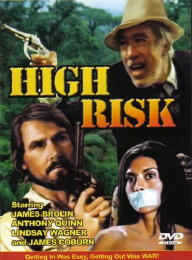
Some of the people leaving comments on IMDB after viewing this film — and quite a large number of them liked it a lot — felt that the reason it did not do well at the box office at the time of its theatrical release was because of its competition. Soon after High Risk was in the theaters, along came its nemesis — Raiders of the Lost Ark.
Hmm. On a scale of 100 for Raiders of the Lost Ark, I’d rate High Risk as a 5. No comparison. Raiders was brisk, inventive, innovative and vastly entertaining. In spite of cast of well-known names, Risk is (e) none of the above.
The pace is sedentary in comparison; the plot rewarmed and stale; and only entertaining enough to keep me watching, which is hardly a recommendation. It does have Lindsay Wagner in it, for whom I have always kept a figurative light on in the window, but it also has Anthony Quinn. When the latter’s usual chewing of the scenery begins, it’s all but lights out for me.
Plot: Four suburban “mercenaries,” amateurs all, led by James Brolin take a risky trip to an unnamed South American country to relieve a drug warlord (James Coburn) of some misbegotten gains, to the tune of five million dollars. In on the deal are a black (Cleavon Little), a Hispanic (Chick Vennera) and a dork (Bruce Davison), not to mention a small fluffy white dog. (Yes, certainly you may ask.)
Of course things go wrong, and very quickly. In an adjoining jail cell is a lovely American woman convicted of smuggling drugs (Lindsay Wagner). A gang of revolutionaries turned bandits also on their trail is led by Anthony Quinn, and of course they too want the money. There is an engaging light-hearted tone to the caper until the revolutionaries appear, but once they do, you get the feeling that the people responsible for the story had run out of ideas at just about the same time.
And lots of gunfire erupts. Lots and lots. To no avail. There’s no Indiana Jones in this bunch. Maybe they should have made Lindsay Wagner’s part larger. They really should have. And yes, I know. I’m not being fair. Raiders of the Lost Ark is one of the greatest movies of all time, regardless of genre.
Sat 16 Jun 2007
PETER RABE – Murder Me for Nickels
Gold Medal 996; paperback original. First printing: May 1960. Trade paperback, paired with Benny Muscles In: Stark House Press, 2004.
First of all, if you haven’t read it, you might want to take a look at an interview that George Tuttle did with Peter Rabe, shortly before his death in May 1990. It’s on the primary Mystery*File website, complete with cover photos and a bibliography which I compiled for the author, making it unnecessary for one to include one with this review, or at least I won’t need to if you go and come back.
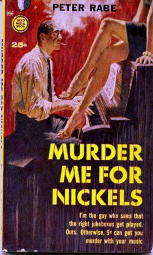
When I was 16, 17 and 18, Peter Rabe was one of my favorite crime fiction authors, but it’s been several years since I’ve read this particular one, until now. It’s probably been even more than several. The usual trepidation comes into play at times like this. The question at the back of my mind is — and I imagine this happens to everyone, eventually — is he as good as I remember him?
The answer is yes, but I know I’ve just read this with different eyes and a different mind than when I read it for the first time, having just finished my first year of college in 1960 and plenty wet still behind the ears. You’ll get the present me talking about it now, not the callow youth I was back then.
My favorite detective writer back at that time was Erle Stanley Gardner, to make a small distinction between styles, and I’ll be catching up with one of his books sometime in the near future. My other favorite mystery writer, noir style, was Cornell Woolrich, who’s still the master of whatever genre of mystery fiction you may care to put him in.
Reading one of Rabe’s books, though, is like opening a case of dynamite. You do it carefully, and you hold your breath just a little. Jack Saint Louis is the primary character in this one, and the narrator. He’s the right hand man of Walter Lippit, businessman racketeer and owner of the single jukebox supplier for a 30-mile radius around town. I don’t think the town is specified, but it’s not a small town, and it’s not that far from Chicago.
Jack is tough when he needs to be, but he’s also smart when he needs to be, which is often, as he has a few things on the side, such as Walter’s girl friend Patty and a recording studio of his own. When outsiders begin crowding in on Walter, the intricate balancing act that Jack is doing becomes more and more difficult to maintain.
Told in an authentic but subdued tough guy vernacular, this is a straightforward gangster novel, not pulp fiction, but an intellectual gangster novel, but a nuts and bolts one, not a literary gangster novel such as The Godfather. Every once in a while, though, Jack’s emotions can’t be held in any longer. When he lets loose, watch out. He’s still tough and terse, don’t let me mislead you. Let’s see if quoting from page 113 will show you what I mean:
I have never shot anyone, and I don’t think shooting’s easy. It isn’t like throwing a stone, or a punch, or anything like it. You press the trigger, and the thing is out of hand. It’s out of your hand; something else does the hating, and you’ll either fear the damage you’ll do or you know ahead of time that you’ll be left as before; same hat, same rage, just a bullet gone. And someone dead whom you did not even touch.
Benotti rushed me. While I stood around he made his rush. He cracked me across the side of the face and before the pain even came I felt like going to pieces. I had held back too long. I rocked across the aisle, hit a rack, and cracked open. That ball inside, is what I’m talking about. Then I was almost done and so was Benotti. My reach is better and I had the pistol.
I pistol whipped him, and I hit and hit, but not a watermelon, or a sack, but always Benotti.
He was just short of raw meat when I left him and I was done.
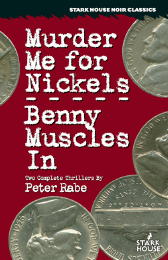
Rabe is a wizard at dialogue, too. One early sexy love scene between Jack and Patty goes on for six pages, for example, and over 80% of it is in dialogue, with just enough narration by Jack to, well, it’s just enough. After reading this, you will be convinced that every other paperback writer goes in for overkill.
If this is not your kind of book, I think this review will have convinced you of that. If it is your kind of book, I think this review should have convinced you of that also. What more can I tell you?
Sat 16 Jun 2007
ROBERT BARNARD – The Case of the Missing Brontë
Dell 11108; paperback reprint, May 1989. Hardcover edition: Scribner’s, 1983. Previous Dell editions: June 1984; 1986. Penguin, paperback, November 1994. First published in the UK: Collins Crime Club, 1983, as The Missing Brontë.
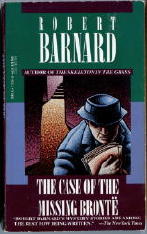
This was – I have a confession to make – my first reading of a Robert Barnard mystery novel. I don’t know why that should be so. I just never read one before. But at a library sale not too long ago, and I got there late, mind you, and in the mystery section of the paperback tent were, lined up all in a row, about a dozen of his books. I couldn’t resist. I grabbed them all, and this is one of them.
Not knowing what to expect, it’s difficult to suggest that I was disappointed, because I wasn’t, but it (um) wasn’t exactly what I expected. I had the strong sense that Barnard’s books are filled with an understated British humor, and in that regard I was right. But I also expected more detection (or deduction, to choose the right word, which never hurts) than there is in The Case of the Missing Brontë. There may be detection on the part of Scotland Yard Superintendent Perry Trethowan, but I think that his wife Jan may have done more of the deducing in this book than does Perry, she having taken an interest in the case even though having never read one of the Brontë books before –
I’ll start at the beginning, which is very, very funny, with the Trethowan family (one son) on a short summer holiday and stopping for a short respite in a small Yorkshire village, in which mother and father meet an old woman in a pub with a story: a find that she had made in some old family papers.
Could it be the manuscript of a never-published Emily Brontë novel? The Trethowans are quickly convinced, but so are other members of Miss Edith Wing’s family (distant relatives) and assorted thugs and academics – don’t be concerned; it’s easy to tell them apart, most of the time. The academics are simply thuggish in more refined ways.
When Edith Wing is knocked on the head and the papers stolen, Trethowan has a case on his hands officially, but why Scotland Yard allows such a leisurely investigation to occur on such a minor matter is a (shall we say) a mystery. But we (the reader) are thankful that they do, as the resulting novel is small marvel of small town japery and incisive cultural commentary, British style, through and through.
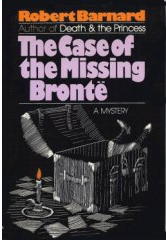
A few quotes will suffice to illustrate, perhaps. From page 38. Perry is interrogating the Reverend Amos Macklehose, the aforementioned distant cousin:
“ [have you a notion] of anyone who might have had special motive for doing Miss Wing harm?”
“No, indeed. Indeed, no. A harmless spinster lady, and a true friend and kind nurse in time of distress. Who could find a motive for violence in the blameless life of such a one? You must look to th violence of the age, Superintendent. The inborn seed of wrath. Only last night on television – our Tabernacle congregation has after much heart-searching and prayer come to the conclusion that there is no intrinsic reason why television should not be regarded as one of the Gifts of God –”
“Really? I can think of any number.”
Or from page 95, Perry again:
… I had bungled the whole thing.
Not that I would have been likely to get much out of any further overheard conversation. Eavesdropping on a foreign conversation is a bit like observing the sex life of earwigs – a lot’s going on, but you don’t get the point of it at all.
Barnard, I have neglected to say, has written a large number of mystery novels, most of them, I feel somewhat able to say, very much like this one, or at least I suspect so. Some of them are standalone thrillers, while others have other series characters other than Trethowan, with occasional instances of crossovers by the characters between them. Here are the ones in which the latter appears, thanks to Al Hubin’s Crime Fiction IV, the point being that I hope to be reading another one soon. Listed chronologically:
TRETHOWAN, INSP. PERRY
o Sheer Torture (n.) Collins 1981 [US: Death by Sheer Torture]
o Death and the Princess (n.) Collins 1982 [US: The Cherry Blossom Corpse]
o The Missing Brontë (n.) Collins 1983 [US: The Case of the Missing Brontë]
o Bodies (n.) Collins 1986
o Death in Purple Prose (n.) Collins 1987 [US: The Cherry Blossom Corpse]
Fri 15 Jun 2007
To supplement Bill Deeck’s reference work about lending-library mysteries, Murder at 3c a Day, I’ve just uploaded scans of the covers of those that Hillman-Curl published in 1938, 24 of them in all. Authors with more than one book from H-C that year were J. S. Fletcher, Norman Forrest [Nigel Morland], Paul Haggard, E. R. Punshon and Edmund Snell.
I asked Bill Pronzini, who’s been supplying me with the covers to upload, if he could recommend any of the titles from 1938. Are there any unknown gems in the lot? His reply:
“The Haggards aren’t bad, particularly Death Talks Shop. Slangy, eccentric, and super fast-paced, reminiscent (to me anyway) of Theodore Roscoe’s two novels for Dodge. Roger Torrey’s 42 Days for Murder is a pretty good pulpish private eye novel. The two John Donavans [one from 1937] are decent fair-play deductive mysteries. The [Vivian] Meik is a Sax Rohmerish adventure mystery with a screwball plot. I haven’t read a lot of the others.”
Fri 15 Jun 2007
MIKE HAMMER: SONG BIRD. 2003. Movie compiled from two episodes of Mike Hammer, Private Eye, May 10 & 17, 1998. Stacy Keach, Shannon Whirrey, with Jack Sheldon, Moira Walley, Frank Stallone. Based on characters created by Mickey Spillane. Director: Jonathan Winfrey.
As far as I’m concerned, Stacy Keach is Mike Hammer on TV. Not Mickey Spillane’s Mike Hammer, I didn’t say that. But as a savvy, trenchcoat-wearing private eye handy both with a gun (Betsy) and a quip – “Lila B. went through piano players like Janis Joplin did bottles of whiskey” – who just happens to be named Mike Hammer on the small screen, there simply is or was no better.
The TV series that this film was taken from was the third or fourth time he’d taken the role, if I have the chronology correct. I’m taking this information from http://www.stacykeach.com/hammer-series.htm, but I’ll take the responsibility if I happen to be restating it incorrectly.
1. MICKEY SPILLANE’S MURDER ME, MURDER YOU. (1983, CBS, TV movie)
2. MICKEY SPILLANE’S MIKE HAMMER. (1984-1985, CBS, series). 22 60-minute episodes.
3. THE NEW MIKE HAMMER. (1986-1987, CBS, series). 22 60-minute episodes.
4. MIKE HAMMER, PRIVATE EYE. (1997, syndicated series). 26 60-minute episodes.
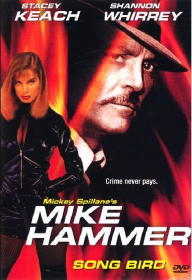
By the time the syndicated series came along, episodes of which I don’t remember ever seeing before, he seems to have mellowed into the part, fitting into the role as if it were an old shoe, an old dog who no longer needs to learn new tricks. In this series Velda was played by Shannon Whirrey, who gets second billing on the DVD case. Whirry began her career playing what are generically called erotic B-movies. Playing Velda was a step up into better roles.
“Song Bird” is a heartfelt homage to jazz, smoky jazz clubs, jittery, jiving jazz musicians and jazz singers that doesn’t make a lot of sense as a murder mystery, but I’ve watched it twice in the last couple of months, and I’m bound to be watching it a few times more.
Jack Sheldon in the real world is a wise-cracking jazz singer and trumpet player who in “Song Bird” plays a wise-cracking jazz singer and trumpet player named Des Long who has a jazz band and who’s a good friend of Mike Hammer. Moira Walley’s name is not even on the DVD case. She’s the thin, blonde, and slightly flighty jazz singer Lila B. who drops in for a few sets with Des’s band every so often, as the mood strikes her, and who’s in love with Johnny Dive (Frank Stallone) a gangster who’s gotten in bad with the boss of the mob he’s a member of, and who is not likely to survive very much longer as a result.
Forget the story. I can’t even find a decent photo of Moira Walley to show you, but she’s as perfect in the role of Lila B. as Jack Sheldon is playing Jack Sheldon. Or Stacy Keach playing Mike Hammer. The rest of the cast may not even need to be there, except that there is a story, one which I’ve already suggested that you forget.
And forget the lousy reviews that Moira Walley received. Off-key warbling? No way. The role she plays may be off-key, intentionally, but hardly the warbling. A weak vocalist who reaches for every note and only looks flustered and out of it when she’s required to say lines? The guy must have been watching another movie altogether. Forget him too.
Watch this one for the music, and don’t forget to listen. They’re all having a great time, gats, gorgeous girls and gams (and more), gangsters and jazzheads, and so did I.
Thu 14 Jun 2007
MANNING COLES – No Entry
Carroll & Graf, paperback reprint; 1st pr., November 1985. Hardcover editions: Hodder & Stoughton (UK), 1958; Doubleday (Crime Club), June 1958. Hardcover reprint: Mystery Guild [book club], July 1958. Contained in Five Spy Novels, Howard Haycraft, ed., Doubleday, Oct 1962. Other paperback edition: Ace D-389, no date stated [1959].
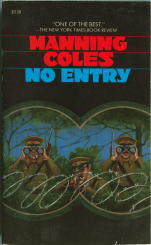
I imagine that if you know anything about Manning Coles the author, you may already know that there never was a Manning Coles. The semi-jovial spy thrillers that appeared under his name were actually written by two friends and neighbors in England, Cyril Henry Coles (1899-1965) and Adelaide Frances Oke Manning (1891-1959), all but a few of them starring the steadfast British agent, Tommy Hambledon.
Some of this information came from Tom and Enid Schantz’s introduction to the four ghost novels that Manning Coles also wrote (appearing under the byline Francis Gaite in England) and which the Schantzes have reprinted as part of their highly recommended Rue Morgue line of books. But according to Tom and Enid, Cyril Henry Coles wrote the last three Hambledon books after his collaborator died, but Hubin’s Crime Fiction IV lists only the last two as having been written by Coles and without Manning:
Search for a Sultan [by Cyril Henry Coles & Tom Hammerton]. Hodder, 1961, hc; Doubleday, 1961.
The House at Pluck’s Gutter [by Cyril Henry Coles & Tom Hammerton]. Hodder, 1963, hc; Pyramid, 1968.
Question: Was the previous book [Crime in Concrete (Hodder, 1960, hc). U.S. title: Concrete Crime. Doubleday, 1960] written by C. H. Coles alone or with another collaborator?
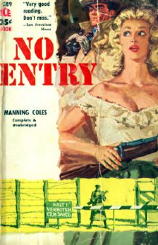
No matter how it works out, this places No Entry as either the last or next-to-last in Manning’s tenure, and unfortunately it’s not one of the better one in the series. If you don’t start with the first two, Drink to Yesterday (Doubleday, 1940) and A Toast to Tomorrow (Doubleday, 1941), preferably in that order, then any of the other immediate post-war books will do. In No Entry, however, decidedly a Cold War novel, the two authors seem to have run out of steam.
It’s not entirely a book not worth your time, but the minute the young naive son of a British diplomat unwittingly crosses the border from West Germany to East, and Hambledon arrives to see what he can do about the situation, you know that he’s going to find a way across the nearly impenetrable border, and make his way back out again.
None the less, Coles – from now on “Coles” will refer to Coles the pair – has a beautifully laid-back way with dialogue that I can’t describe better than that, but which tickles my fancy every time I read one of their books. Take, for example, the following passage occurring early on, on page 20, after Hambledon finds a body in his hotel room. (Nothing like starting a story with a quick bracer to the spine like this.)
Hambledon nodded. “He is still there. The reason for disturbing you at this unreasonable hour was to ask you to be so good as to have him removed.”
“But he – is he being held – what did he say – who is he?”
“I don’t know who he is except that he is not George Micklejohn, and he said nothing. He is quite dead, mein Herr, of a bullet through the head.”
“Dead,” said the Chief of Police, rising to his feet and pressing a bell on his desk, “dead, in your room –”
“Without being unduly squeamish,” said Tommy Hambledon, “I dislike corpses in my bedroom. Disconcerting. Unhygienic.”
Here’s another relatively long quote that will tell you some more about the complications that occur in the story as it goes along. From page 66, as the man driving Hambledon around the area next to the border says:
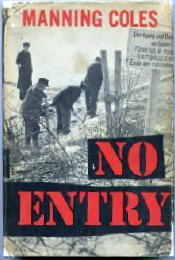
“I have told the Herr all I know, I think. It is all vague, nobody knows anything definitely, and one whispers stories from one to another, they are not very reliable, the Herr knows? Some plans were stolen, it is said, the Russian army by an officer, and this young Englishman had them. He was captured and escaped again. The Russians were still looking for him yesterday so he must be in hiding somewhere but nobody knows where. If anyone were hiding him they would not talk, naturally.”
“I suppose not. No.”
When Hambledon finally does cross the border, it is in a old automobile constructed of various makes and models, and he adds some gunk to the engine to make it misfire uncontrollably, belching black smoke and threatening almost to explode if one were to look at in a threatening manner. Which is a huge amount of fun to read until you (the reader) realize that there really is no point to such a matter of calling so much attention to oneself, if you are in enemy territory under false pretenses and with high hopes of retreating back across the border with another person with you.
Does such behavior make you less suspicious? Does it draw attention away from you and more toward the automobile? What sort of agent would behave in such a fashion, he must not be an agent, perhaps? I’m the one supplying the possibilities. Coles does not. The uproar goes on, stops, and with or without it, the story seems to continue as it would have, either way.
And while things do not go smoothly, naturally, crossing the border back again still seems all too easy. (I am discussing matters of plot importance that I would not generally do, but as it is clear from the beginning, as I pointed out before, that this is what the story is going to be, in essence, and what is going to happen, I do not believe that I am being unwise in doing so.)
Coles seems to be very familiar with the area in which the story takes place, which adds immensely to the pleasure provided by say, the first two-thirds of the book. The final third is where the letdown occurs, and even so, it doesn’t make this a bad book, only one that’s disappointing in a way that suggests that it might have been better.
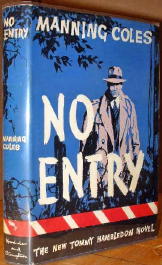
PostScript: I’ve never really had a solid picture in my mind of what Tommy Hambledon looks like. If I think of the various “Tommy”s that I know, none of them, I do not believe, resemble Mr. Hambledon. As I was reading, therefore, I made notes of any mention of his physical appearance that Coles provided, and perhaps it was deliberate, but there were not many:
Page 19. “broad shoulders”
Page 91. “blue eyes”
Page 129. “he was not a tall man”
Page 165. “… slipped like a prowling cat”
And that’s it. I haven’t tried to look elsewhere, online or in any of the other Manning Coles books I have. I’ll allow you to tell me more, if you can?
« Previous Page — Next Page »
